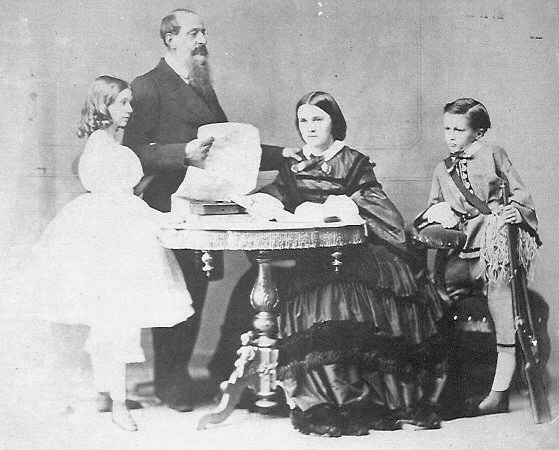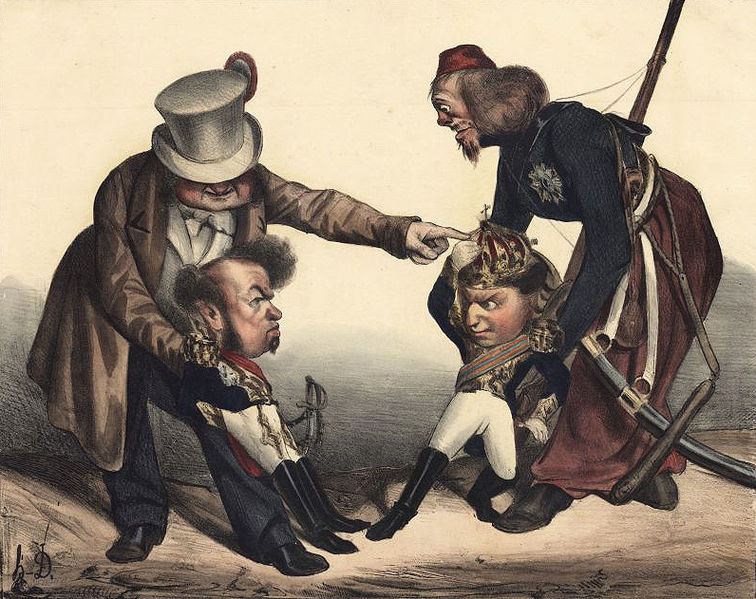<Back to Index>
- Chemist Thomas Martin Lowry, 1874
- Painter Aert de Gelder, 1645
- King of Portugal and the Algarves Miguel I, 1802
PAGE SPONSOR
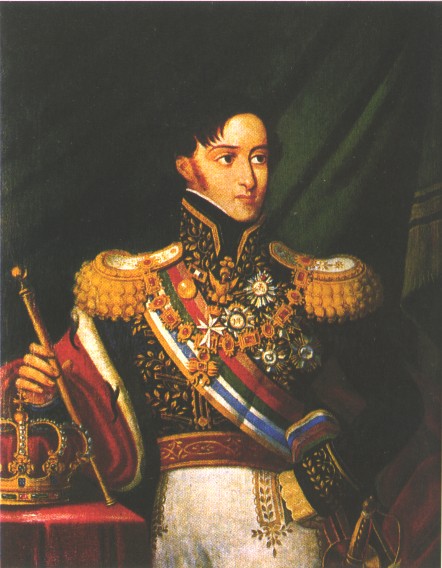
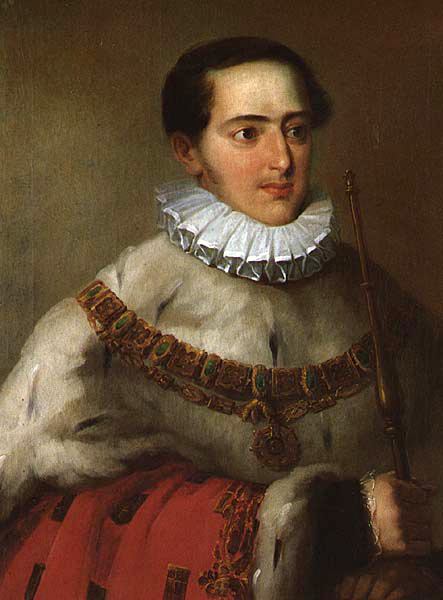
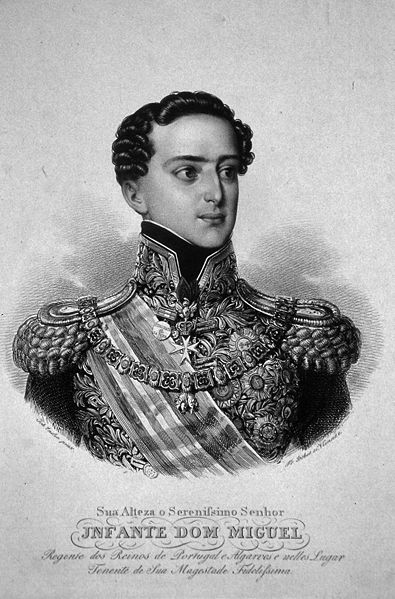
Dom Miguel I, sometimes Michael (26 October 1802, Lisbon – 14 November 1866, Bronnbach, Grand Duchy of Baden), was the King of Portugal between 1828 and 1834, the seventh child and second son of King John VI and his queen, Charlotte of Spain.
Following his exile as a result of his actions in the Abrilada, Miguel returned to Portugal as regent to his niece Maria da Glória (future
Queen Maria II), and potential royal consort. As regent, he claimed the
Portuguese throne in his own right, since according to the so-called Fundamental Laws of the Kingdom his older brother Peter IV and
therefore the latter's daughter had lost their rights from the moment
that Peter had made war on Portugal and become the sovereign of a
foreign state (Brazil).
This led to a difficult political situation, during which many people
were killed, imprisoned, persecuted or sent into exile, and which
culminated in the Portuguese Liberal Wars between authoritarian absolutists and progressive constitutionalists. In the
end Miguel was forced from the throne and lived the last 32 years of
his life in exile. Miguel
Maria do Patrocínio João Carlos Francisco de Assis Xavier
de Paula Pedro de Alcântara António Rafael Gabriel Joaquim José Gonzaga Evaristo, the second son, of King John VI and Charlotte / Carlota Joaquina, was born in the Palace of Queluz, Lisbon. Some sources have suggested that Miguel I could be the illegitimate son
from an adulterous affair between his mother, Queen Charlotte, and one
of her alleged lovers. Apparently sources close to King John VI
confirmed as much by asserting that he had not had sexual relations
with his wife for two and a half years prior to Miguel's birth (a period when his parents carried out a conjugal war,
during which they were involved in permanent conspiracies, and only
encountered each other in rare official circumstances). But
despite the gossip, Miguel was always considered to be a son of the
king, by the king, by his mother, by the rest of the family, by the
court, and by the church. The "illegitimate child theories" may have
had their origins in the writings of pro-liberal propagandists or
royalists who wanted to denigrate the queen and undermine the claims of
Miguel and of his descendants to the Portuguese throne. What
is clear, is that Miguel was the queen's favourite child. After the
death of her firstborn, it was Miguel who received most of her
attention, rather than Peter, who was closer to his father, In 1807, at the age of 5, Miguel accompanied the Royal Family to Brazil in order to escape from the first Napoleonic invasion of Portugal; he
returned in 1821 with John IV and his mother, while his brother Peter
remained behind as governor of Brazil. From dawn to dusk, Miguel was a
mischievous child, sometimes seen in the miniature uniform of a general. At
sixteen he was seen galloping around Mata - Carvalos, knocking off the
hats of passers-by with his riding crop. He spent most of his time with
a rowdy band of half-caste or Indian farm hands. In
general, Miguel was spoiled by the queen and her royal household; and
clearly influenced by the base tendencies of others. The Duke of Palmela described him as: Miguel was an avowed conservative and admirer of Prince Klemens Wenzel von Metternich, who had referred to the liberal revolutions in the 1820s as unrealistic and without any historical roots: Miguel was 20 years old when he first challenged the liberal institutions established after the 1820 revolution, which may have been a part of a larger strategy of the queen. He was at the head of the 1823 counter revolution, known as the Vilafrancada, which erupted on May 27, 1823 in Vila Franca de Xira. Early in the day, Miguel joined the 23rd Infantry Regiment, commanded by Brigadier Ferreira
Sampaio (later Viscount of Santa Mónica) in Vila Franca, where
he declared his support for an absolutist monarchy. He immediately
called on General Pampluna (later Marquis of Subserra) to join him and
his cause. The general, not a fan of the liberal constitution, obeyed
his summons and within five days controlled the insurrectionary forces. The
prince, supported by the queen, went so far as to demand the abdication
of the king, who, faithful to his earlier oath, wanted to maintain the
1822 Constitution, despite the growing support for absolutist forces in
Vila Franca. Miguel and the queen were
interested in overthrowing the parliamentary system and, inspired by
the return of the absolutist monarchy in Spain (where the Holy Alliance and
French Army had intervened to destroy the liberal forces there) they
exploited factionalism and plotted with outside reactionaries to
overthrow the liberal Cortes. But General Pampluna was loyal to the
king, and made it perfectly clear that he would do nothing to defy the
monarch, and advised the prince to obey his father's summons. The king
himself marched on Vila Franca where he received the submission of the
troops and his son. But he also took advantage of the situation to
abolish the 1822 Constitution and dismiss the Cortes. Many liberals
went into exile. Although Miguel returned to Lisbon in triumph, the
king was able to maintain complete control of power and did not succumb
to the ultra-reactionary forces that supported his abdication. After the events of the Vilafrancada, Miguel was made Count of Samora Correia and appointed Commander - in - Chief of the Army (Generalissimo). But the queen could not tolerate the king's continuing benevolence
towards liberals and moderates, nor that he continued to be influenced
by and to support ministers such as Palmela and Pamplona, who were more moderate in their outlook. The mysterious death of the Marquis de Loulé in Salvaterra on
February 28, 1824, in which it was suspected that Miguel or his friends
were involved, was a symptom of the instability of the period. Prince
Miguel was always influenced by his mother; and two months later, on
April 30, 1824, as Commander - in - Chief of the Army he gathered his
troops and ordered them to arrest ministers and other important people
under pretext that a masonic conspiracy to assassinate the king existed, and placed his father in protective custody and incommunicado at Bemposta, where Miguel could "defend and secure his life". The Abrilada, as this was to be known, worried many of the foreign powers. The foreign diplomatic corps (and in particular Marshal Beresford),
realizing that the king was a prisoner of his son, traveled to Bemposta
and was able to ferry the king away and on board a British warship, the Windsor Castle. On board, the king summoned his son, whom he dismissed as Commander - in - Chief of the Army, immediately exiling him to Vienna, where he remained for over three years. While in Vienna, he was a guest and friend of the Prince Metternich.
Meanwhile, on March 10, 1826, his father, King John VI, died and his
brother Peter, the heir to the throne, became king as Peter IV. Peter,
however, was committed to continuing as Emperor of Brazil and therefore
abdicated the crown of Portugal in favor of his daughter, Infanta Maria da Gloria. Since the young sovereign was not yet of age, he instituted a regency, under his sister, Princess Isabella Maria.
Peter had already attempted to coerce Miguel to Brazil (1822) away from
their mother without any success. Following the death of their father,
Peter once again attempted to mend fences within the family and ensure
Maria da Gloria's right to the throne by offering Miguel the regency of
Portugal (when he became 25) under a new liberal Constitutional Charter
that would re-establish a constitutional monarchy. Under this
arrangement, Queen Maria II and Miguel would be married when she came
of age; until then Miguel would be her regent in Portugal. The new
Constitutional Charter gave the crown moderating authority between the
legislative, executive and judiciary, and introduced a 100 member
Chamber of Peers (which included aristocrats and bishops and
archbishops), a royal veto and indirect elections. Miguel
accepted the proposal from his brother, swore to uphold the
Constitutional Charter and, since the young Queen was only nine years
old, waited until she would reach the age of marriage. The regency under Isabella Maria was extremely unstable; discord reigned in the government, there were divisions within the municipal councils, rivalries between ministers and at one point, after the resignation of General Saldanha, a revolt in Lisbon. With Princess Isabella Maria dangerously ill, Peter resolved to entrust his brother Miguel with the kingdom, which Miguel was only too eager to accept. A decree was promulgated on July 3, 1827 that granted Miguel his new role, and he departed from Vienna for Lisbon. On the trip back to Lisbon he stopped in England, arriving on December 30, 1827. He was met by the Duke of Clarence, the Admiral of the English Navy, and by other upper members of the English Court who had gathered at the dock to meet him. Arthur Wellesley, 1st Duke of Wellington, then leading an unpopular Tory government,
hoped that they could mold Miguel into accepting the constitutional
framework that Peter IV had devised, and used this visit to facilitate
the transition. After
lunching at the Hospital Governor's home, he traveled to London with
his entourage in regal carriages and, escorted by cavalry officers, to
the Palace of Westminster where he was met by a throng of people. While in London he stayed at the palace of Lord Dudley,
on Arlington Street where he entertained his new friends; he was
received by the ministers, ambassadors and municipal officials of King George IV, and was generally feted by English nobility, attending concerts and pheasant hunts, and visiting public works (such as the Tamisa tunnel which was then under construction and, ironically, collapsed after his visit). On New Year's Eve he visited the King at Windsor Castle and
was honored with a magnificent banquet. Later at Rutland House, Miguel
received members of the Portuguese diaspora living in England, who
presented him with a commemorative medallion. Throughout his visit he
was generally well received. On January 13, 1828, Miguel departed London; after spending some time at Stratfield Saye, the country home of the Duke of Wellington, he travelled to Plymouth en-route to Lisbon. Due to bad weather, he was only able to transfer to the Portuguese frigate Pérola on February 9, which arrived in England accompanied by two British ships. On January 22, the Gazeta de Lisboa (English: Lisbon Gazette) published an open letter from the Ministério da Justiça (English: Ministry of Justice)
which permitted any general demonstrations of jubilation (unless
otherwise prohibited by law). The prince's ship arrived in Lisbon on
February 22 and was met by cannon salvos from ships along the Tagus River and from the hilltops, beginning at two in the afternoon. The river was filled with ships when the Pérola arrived. Although it was expected that the new regent would disembark at the Praça do Comércio, where a stage had been constructed, Miguel preferred to disembark in Belém.
It is believed that Miguel's mother had sent a boatman to pick up the
prince and with a message to see her upon arriving in Lisbon, in order
to tell her where his loyalties lay. On
shore the local population acclaimed their regent with cheers, while
bells rang from some church towers and cheerful hymns were sung in the
streets. There was a triumphal march to the Ajuda Palace, along streets adorned with silk banners, while the ladies of the city
threw flowers. Everywhere there was a multitude of citizenry yelling "Viva o Senhor D. Miguel I nosso rei absoluto" (English: Long live Sir D. Miguel our Absolute King), while some interjecting cries of "death to D. Pedro" and "death to the liberal constitution". But
Miguel's role was clearly delineated by his first night in Lisbon: he
would govern as regent in the name of the rightful sovereign of
Portugal, Queen Maria II. On her reaching marriageable age, Miguel
would be her consort. Furthermore, Miguel was obliged to govern in
conformity with Peter's Constitutional Charter, something he accepted
as a condition of the regency (even if he did not agree with its
principles and favoured an absolute monarchy instead). On February 26, in the main hall of the Ajuda Palace in
the presence of both Chambers of the Cortes, the Royal Court and the
diplomatic corp, as well as some of the Prince's colleagues from Brazil
(carefully orchestrated by the Queen Dowager), the investiture began. At one o'clock Miguel, along with his sister, Infanta Isabella Maria,
entered the chamber to formally hand over the Regency. After the
spectacle of both of them in the same chair, the princess delivered the
transitional oath and then left gracefully. Miguel was presented with
the written oath to defend the Constitutional Charter along with a
Bible, which caused him "...confusion and [he] seemed unable or unwilling to read it." It
is also unclear whether he actually swore the oath, since there was no
distinct enunciation of the words; nor did any one actually see him
kiss the missal (since the Duke of Cadaval obscured the prince during
this part of the ceremony). Lord Carnarvon, in Lisbon at the time of the ceremony, wrote of the conclusion of the scene: On
March 1 some citizens of Lisbon gathered at the palace to acclaim D.
Miguel "Absolute King", infuriating many of the liberal politicians and
residents. Invested in his new title of regent, he presented his
Ministers of State in the evening: Nuno III Álvares Pereira de
Melo (Duke of Cadaval), José António de Oliveira Leite de Barros (later Count of Basto),
Furtado do Rio de Mendonça (7th Viscount of Barbacena & 2nd
Count of Barbacena), José Luis de Sousa Botelho Mourão e
Vasconcelos (Count of Vila Real)
and the Count of Lousã. Within a week numerous moderate army
officers had been dismissed and the military governors of the provinces
replaced, as the Prince and Queen Dowager "cleaned house" of their old
enemies and liberalist sympathizers.
On
March 13, 1827 Miguel dissolved the Cortes without calling new
elections, as stipulated in the Constitutional Charter. Some municipal
councils, many nobles and clergy, and several important citizens requested that the regent revoke the Constitutional Charter and reign as king. Blood was first spilled by the liberals, when delegates from the University of Coimbra (who
ostensibly traveled to Lisbon to present their compliments to Miguel)
were murdered on March 18 by hot-headed Coimbran students. On
April 25, the senate (of the university) issued a proclamation in
which they requested that Miguel assume the throne. This only fueled
the divisions between liberals and absolutists. Because of the
independence of Brazil, Miguel's supporters considered Miguel to be the
legitimate heir to the crown of Portugal. If,
to liberals, the name of Miguel was despised, to the legitimists (the
absolutists) it was venerated. But Miguel's reign was immediately
marked by cruel, almost tyrannical, governance which some attribute to
him personally; however some blame the injustices on his subordinates,
while others attribute them to the malevolence of Queen Charlotte. On
May 3, 1828, the very nobles who had been nominated by Peter to the new
Chamber of Peers met in the Palace of the Duke of Lafões, and
invited Miguel to convoke a new cortes consisting of the Three Estates
with a view to deciding the legitimate succession to the throne. Such a cortes met in June at Ajuda,
where the Bishop of Viseu proposed that Miguel should assume the crown
since "...the hand of the Almighty led Your Majesty from the banks of
the Danube to the shore of the Tagus to save his people...". On July 7
D. Miguel was acclaimed as absolute ruler, and on July 15 the Three
Estate Cortes closed. Shortly afterwards the military garrison in Oporto revolted, formed a provisional governmental junta, and marched on Coimbra to
defend the liberal cause. But the general in command of these troops
was indecisive, and Miguel was able to raise his own troops, create a
battalion of volunteers and blockade Oporto. In Lagos a
similar revolt was attempted, but immediately quashed when the liberal
General Saraiva was shot by the Miguelist General Póvoas. On
this occasion, João Carlos Saldanha (later Duke of Saldanha) and Pedro de Sousa Holstein (later 1st Duke of Palmela), who had arrived from England on board the British ship Belfast in
order to lead constitutional forces, quickly re-embarked, judging the
liberal cause lost. The liberal army escaped to deplorable conditions in Galicia where
they awaited the next move. In the former regency's court there were
few strong supporters of a constitutional monarchy; Princess Isabella
Maria was supported by weak willed ministers or incompetents and was
personally too timid to stand up to Miguel. The
liberal elite and their supporters escaped into exile. All of Portugal
recognized the sovereignty of the monarch, except the islands of Madeira and Terceira; Madeira was easily subjugated, but Terceira remained faithful to the liberal cause. The excess zeal of his supporters to prosecute the liberals would blacken the reputation of Miguel's regime. During the liberal insurrection on March 6, 1829, in Cais do Sodré,
Brigadier Moreira, his officers and their supporters were all
bayoneted. On May 7, the members of the rebel garrison of Oporto who
had revolted were also executed. In some cases, the local population
contributed to these horrors and reprisals, as in Vila Franca da Xira where
they assassinated 70 people believed to have liberal sympathies.
Although these actions were disapproved of by many of Miguel's
ministers, the Count of Basto was not one of them. Even the Viscount of Queluz,
a medic and intimate friend of Miguel, was exiled to Alfeite for
joining the chorus of those who challenged the reprisal killings. But
the Queen Mother continued to support the attacks on liberals, and
motivated these actions in order to strengthen the monarchy. Even after
she died on 7 April 1830, many atrocities continued to be committed in
the name of Miguel, some against foreign nationals who intervened in
the politics of Portugal. While Spain, The Holy See and the United States recognized Miguel as king, in England and France there was little public support for the regime. The
imprudence that the Miguelist government showed in harassing English
and French foreign nationals provoked them to protest. Eventually
Admiral Albin Roussin, was ordered by Louis Philippe I (who, like England, could not obtain any diplomatic satisfaction), to take action; he sailed up the Tagus,
captured eight Portuguese ships and forcibly imposed a treaty (July 14,
1831). But, Miguelist reprisals on liberals continued; most sentences
were carried out within 24 hours. The 4th Infantry, in Lisbon,
registered 29 executions on August 22 and 23, 1831, alone. Only the island of Terceira in the Azores remained loyal to Queen Maria; the constitutional government continued to function there in exile. At first João Carlos Saldanha was unable to reach the island, owing to the hostility of an English cruiser, but the Count of Vila Flor (later Duke of Terceira) was
more successful; he arrived on the island, rebuilt the defences and
quickly beat back Miguel's forces (on August 11, 1829) as they were
attempting to invade the island. By 1831 the liberals had taken over
all the islands of the Azores. Peter,
after abdicating the imperial crown of Brazil, placed himself at the
head of the Liberal Army (1831) and from the Azores launched an invasion of northern Portugal, landing at Mindelo, near Oporto which
he quickly occupied. But Miguel's army was formidable, composed of the
best troops, with dedicated volunteers and enthusiastic militiamen
(although not, perhaps, the best senior officers). They easily encircled the city and lay siege to it. As the defense of Oporto persisted, Miguel resolved to visit his troops in April 1833. But in the meantime Lisbon fell into the hands of the Duke of Terceira, who had left Oporto earlier in the Liberal fleet commanded by Charles John Napier, disembarked in the Algarve and marched across the Alentejo to defeat the Miguelist General Teles Jordão (seizing the city on July 24). Napier, after defeating a Miguelist fleet off Cape St. Vincent, joined the Duke of Terceira in the north, taking control of the Tagus. Miguel was assisted by the French General Bourmont, who, after the fall of Charles X of France came
with many of his legitimist officers to the aid of the king of Portugal
(that is, Miguel). He was later replaced by the Scottish General Ranald
MacDonnell who withdrew the Miguelist army besieging Lisbon to the
almost impregnable heights of Santarém, where Miguel established his base of operations. The battles continued in earnest. In Alcácer the Miguelist forces captured some ground but this was quickly lost to General Saldanha in Pernes and Almoster.
The latter action (February 18, 1834) was the most violent and bloody
of the civil war. In the end, politics sealed Miguel's fate: his
alliance with Carlos of Spain alienated the sympathies of Ferdinand VII of Spain,
who recognized Maria's claim to the Portuguese throne, and concluded a
quadruple alliance with the queen and Peter as well as with the
governments of France and England. The Spanish General Rodil entered into Portugal while pursuing D. Carlos and his small force and at the same time the Duke of Terceira won the Battle of Asseiceira (16 May 1834) making D. Miguel's position critical. Miguel escaped Santarém and moved south-east in the direction of Elvas. While Miguel made for Évora, his generals voted in a council of war to suspend hostilities and sue for peace. Miguel accepted the decision. After a three-year civil war, Miguel I was forced to abdicate at Evoramonte (26
May 1834). While Carlos was transported to England (he later secretly
returned to Spain), Miguel embarked on 1 June 1834 on a British warship
from Sines bound for Genoa; he lived in exile first in Italy, then in England, and finally in Germany. He never returned to Portugal.
In December 1834 the Portuguese
Cortes banished
Miguel and all his descendants from Portugal upon pain of immediate
death. The Constitution of 1838 (article 98) categorically excluded the
collateral Miguelist line from the throne (although with the return to
the Constitutional Charter in 1842, this ceased to have force). The
1834 law remained in effect until repealed in May 1950. During his
exile, he was known as Duke of Braganza, as well as Marquis of Vila Viçosa, Count of Arraiolos, Count of Barcelos, Count of Neiva and Count of Ourém. On 15 January 1837 the Spanish Cortes, then in midst of the First Carlist War (1833 – 39),
excluded Miguel from the Spanish succession, on the grounds that he was
in rebellion along with his maternal uncle Carlos, the first Carlist pretender of Spain. Miguel's eldest sister Teresa, Princess of Beira,
and his nephews (three sons of late Infanta Maria Francisca of
Portugal, and Sebastian, son of Teresa, Princess of Beira) were also
excluded. Miguel
lived the rest of his life in exile and, removed from Portuguese
politics, his character altered radically; in his later years he was a
portly heavily bearded patriarch and lacked the cowboy persona of his
early life. He refused to accede to the terms of the Concession of Evoramonte and thereby forfeited his generous pension from the Portuguese government. He lived for a time as a destitute refugee in Rome, in apartments provided by Pope Gregory XVI, who also gave him a small monthly allowance. In 1851, after spending several years in England, he moved to the Grand Duchy of Baden in southern Germany and married Princess Adelaide of Löwenstein - Wertheim - Rosenberg. They settled in the former Cistercian monastery of Bronnbach, and
raised seven children. His widow succeeded in securing advantageous marriages for all their daughters. Like Queen Victoria, Miguel would become known as the "grandfather of Europe", but this was only after his death. Miguel died while hunting at Bronnbach, Grand Duchy of Baden on 14 November 1866. He was buried in his wife's family's vault in the Franciscan monastery of Engelberg at Grossheubach, Bavaria. In 1967 his body and that of his wife (then resting in Ryde on the Isle of Wight in England) were transferred to the Braganza pantheon in the old Monastery of São Vicente de Fora in Lisbon.
